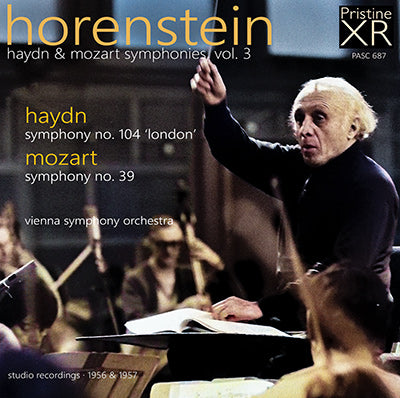
This album is included in the following sets:
This set contains the following albums:
- Producer's Note
- Full Track Listing
- Cover Art
The present release is the third and final volume of a series devoted to Haydn and Mozart conducted by Jascha Horenstein. The collection covers all of his commercial recordings of the symphonies originally released on the Vox label during the 1950s, as well as two recordings taken from live broadcasts of works he did not record commercially. Previous releases in this series have featured the “Clock” and “Military” symphonies by Haydn, and Mozart’s “Haffner”, “Prague” and “Jupiter” symphonies.
Mozart's Symphony No. 39 was recorded as part of the composer’s bicentenary during a busy two week period for Horenstein in Vienna and followed the signing of his second contract for Vox Records on February 1st 1956. The contract stipulated a minimum of five recordings per year, an obligation quickly fulfilled over the next ten days that resulted in recordings of three Mozart symphonies, Beethoven’s Fifth and Ninth, the latter for a long time Horenstein’s best selling LP, Mozart’s Requiem and a couple of Beethoven overtures, and one can only regret that stereo was not an option at that time. According to one source Eine Kleine Nachtmusik was also recorded but this remains a rumour.
The Haydn symphonies were recorded in April 1957 if current research is accurate, and are among Horenstein’s first in stereo. Often the subject of severe criticism, Vox’s engineering of its two Haydn symphonies in this series was more successful than previous efforts and benefits noticeably from Pristine’s restoration, which despite the heavy studio resonance endows the orchestra with a full, rich and enveloping sound.
Horenstein’s approach to both Mozart and Haydn was anchored to its era but even during his time it aroused conflicting reactions. For some his “wholly unconventional” performances made him “one of the finest Mozart conductors of our time”, while his Haydn was often considered “beautiful and spiritually satisfying.” Others took a strongly contrary view, hearing performances that were austere, unsmiling or pedantic with sluggish rhythms that lacked tension and drive. Both views accompanied him in this repertoire throughout his career.
Haydn’s “London” Symphony conducted by Horenstein is gravitas personified. Serious and stately, it is strong of profile and deliberate of pace, weighty but never slack, no matter how slow the beat, and with a strong sense of forward motion. The regal opening Adagio of the first movement determines the relaxed tempo of the ensuing Allegro, which appears to lack forward drive until one realizes that Horenstein views it as a prelude, an introduction to the more elaborate second movement. He clearly views the Andante as the emotional center of the work and exploits its darker harmonies and turbulences to dramatic effect. The third movement, a courtly dance in distorted form, stays flat-footed, rustic and rough around the edges as intended. The finale, whose crisp and constant rhythms come as something of a relief, provide Horenstein with additional opportunities to emphasize the darker sides of Haydn’s drama. The forward placing of the woodwinds and comfortable tempi throughout are characteristic of Horenstein’s approach in this repertoire, allowing the musicians of the Vienna Symphony Orchestra ample opportunity to shine as well as conferring transparency and openness to the orchestral textures.
Mozart conducted by Horenstein is taut, serious and dramatic in the outer fast movements, lyrical, poetic, reflective and warm in the slow inner sections. As a general rule his Mozart can be characterized as strong, virile and anti-romantic. This is true of the E-flat Symphony, a recording that shows Horenstein’s sympathy as a Mozart interpreter. His carefully constructed outer movements exhibit lively rhythms that are slow but never sluggish, the Andante is delicate, songful and expressive with great depth of feeling and the Minuet forceful, rustic and boisterous. Some attributes that distinguish Horenstein’s style are inner energy and drive, forward motion, attention to detail within the phrase and a general sense of purpose and aim.
Misha Horenstein
HORENSTEIN Haydn & Mozart Symphonies, Vol. 3
HAYDN Symphony No. 104 in D major, Hob.I:104, 'London'
1. 1st mvt. - Adagio - Allegro (9:23)
2. 2nd mvt. - Andante (8:46)
3. 3rd mvt. - Minuet. Allegro - Trio (5:53)
4. 4th mvt. - Finale. Spiritoso (5:32)
Recorded in stereo, 27-29 April, 1957, Studio C, Konzerthaus. Vienna
MOZART Symphony No. 39 in E-flat major, K.543
5. 1st mvt. - Adagio - Allegro (9:33)
6. 2nd mvt. - Andante con moto (9:47)
7. 3rd mvt. - Menuetto e Trio (4:08)
8. 4th mvt. - Allegro (4:13)
Recorded 3-4 February, 1956, Brahmssaal, Vienna
Presented in Ambient Stereo
Vienna Symphony Orchestra
conducted by Jascha Horenstein
XR Remastered by Andrew Rose
Cover artwork based on a photograph of Jascha Horenstein
Source recordings from the collection of Misha Horenstein
Total duration: 57:15

